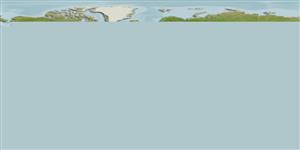Teleostei (teleosts) >
Perciformes/Zoarcoidei (Eelpouts and pricklebacks) >
Zoarcidae (Eelpouts) > Lycodinae
Etymology: Hadropogonichthys: Greek, hadros = stron, big + Greek, pogon = beard + Greek, ichthys = fish (Ref. 45335).
Eponymy: Dr Georgii Ustinovich Lindberg (1894–1976) was a Russian ichthyologist and marine biologist who was a lecturer at Chita University and who was invited (1923) to the Far-Eastern University in Vladivostok where he established a coastal biological [...] (Ref. 128868), visit book page.
Environment: milieu / climate zone / depth range / distribution range
Ecology
Marine; bathydemersal; depth range 200 - 1400 m (Ref. 50610), usually 300 - 500 m (Ref. 56467). Deep-water
Northwest Pacific: northern Kuril Islands to Sagami Bay, Japan. Also known from the Sea of Okhotsk (Ref. 51665).
Size / Weight / Age
Maturity: Lm ? range ? - ? cm
Max length : 37.0 cm TL male/unsexed; (Ref. 56467); common length : 33.0 cm TL male/unsexed; (Ref. 56467); max. published weight: 100.00 g (Ref. 56467)
Life cycle and mating behavior
Maturity | Reproduction | Spawning | Eggs | Fecundity | Larvae
Anderson, M.E., 1994. Systematics and osteology of the Zoarcidae (Teleostei: Perciformes). Ichthyol. Bull. J.L.B. Smith Inst. Ichthyol. 60:120 p. (Ref. 11954)
IUCN Red List Status (Ref. 130435: Version 2024-1)
Threat to humans
Harmless
Human uses
Fisheries: of no interest
Tools
Special reports
Download XML
Internet sources
Estimates based on models
Preferred temperature (Ref.
123201): 0.7 - 3.8, mean 2.9 °C (based on 19 cells).
Phylogenetic diversity index (Ref.
82804): PD
50 = 1.0000 [Uniqueness, from 0.5 = low to 2.0 = high].
Bayesian length-weight: a=0.01000 (0.00244 - 0.04107), b=3.04 (2.81 - 3.27), in cm total length, based on all LWR estimates for this body shape (Ref.
93245).
Trophic level (Ref.
69278): 3.4 ±0.4 se; based on size and trophs of closest relatives
Resilience (Ref.
120179): Low, minimum population doubling time 4.5 - 14 years (Preliminary K or Fecundity.).
Fishing Vulnerability (Ref.
59153): Low to moderate vulnerability (27 of 100).
